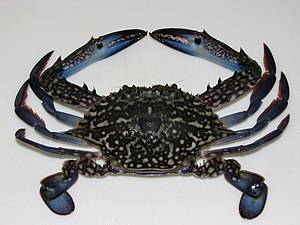タイワンガザミ
Portunus pelagicus/ja
タイワンガザミ, 別名blue crab、blue swimmer crab、blue manna crab、そしてflower crabは、インド太平洋に生息する大型のカニの一種である。インドネシア、マレーシア、タイ、フィリピン、ベトナムの沿岸沖、またオーストラリアのほとんどの地域および東はニューカレドニアまでの汽水域に生息している。
| Portunus pelagicus/ja | |
|---|---|

| |
| オス | |
| Scientific classification | |
| Domain: | Eukaryota |
| Kingdom: | Animalia |
| Phylum: | Arthropoda |
| Class: | Malacostraca |
| Order: | Decapoda |
| Suborder: | Pleocyemata |
| Infraorder: | Brachyura |
| Family: | Portunidae |
| Genus: | Portunus |
| Species: | pelagicus
|
| Binomial name | |
| pelagicus | |
| Synonyms | |
| |
概要
オスは鮮やかな青色に白い斑点があり、特徴的に長い鋏脚を持つ。一方、メスはくすんだ緑/茶色で、より丸みを帯びた甲羅を持つ。甲羅の幅は最大20cmになることがある。
行動
彼らはほとんどの時間、特に日中や冬の間は砂や泥の中に埋まって過ごす。この習性が、アンモニウム(NH4+)やアンモニア(NH3)に対する高い耐性を持つ理由かもしれない。満潮時に出てきて、二枚貝、魚、そして少量ではあるが大型藻類など、様々な生物を捕食する。パドルのような扁平な脚を持つため、泳ぎは非常に得意である。しかし、別のイワガニ科のカニ(Scylla serrata)とは対照的に、長時間水から出て生きることはできない。
Capture
The species is commercially important throughout the Indo-Pacific, where they may be sold as traditional hard shells, or as "soft-shelled" crabs, which are considered a delicacy throughout Asia. The species is highly prized as a substitute for Callinectes sapidus. This species is fished heavily and almost exclusively for meat consumption in the Persian Gulf, with the females sold at higher prices than males.
These characteristics, along with their fast growth, ease of larviculture, high fecundity, and relatively high tolerance to both nitrate and ammonia, (particularly ammoniacal nitrogen, NH3–N, which is typically more toxic than ammonium, as it can more easily diffuse across the gill membranes), makes this species ideal for aquaculture.
The species is commercially fished in Australia, and is also available to recreational fishers and is regulated by various state governments. Relevant recreational fishing regulations for Australia (as of March 2016) are tabled below.
| State | Minimum carapace | Bag limit | Boat limit | Possession Limit | Notes |
|---|---|---|---|---|---|
| South Australia | 11 cm | 20 (Gulf St Vincent) or 40 (combined with sand crabs) | 60 (Gulf St Vincent) or 120 (combined with sand crabs) | N/A | |
| New South Wales | 6 cm | 10 | N/A | 20 | |
| Western Australia | 12.7 cm | 20 or 10 (West Coast) | 40 or 20 (West Coast) | N/A | Cockburn Sound is closed. Peel-Harvey Estuary is closed from 1 September to 31 October. |
| Queensland | 11.5 cm | No limit | No limit | No limit | |
| Northern Territory | N/A | N/A | N/A | 30 | Combined total for any crab species other than mud crabs. |
Ecology
P. pelagicus commonly enters estuaries for food and shelter. Its life cycle is dependent on estuaries as the larvae and early juveniles use these habitats for growth and development. Prior to hatching, the female moves into shallow marine habitats, releases her eggs, and the newly-hatched zoea I larvae move into estuaries. During this time, they feed on microscopic plankton and progress from the zoea I stage to the zoea IV stage (approximately 8 days) and then to the final larval stage of megalopa (duration of 4–6 days). This larval stage is characterised by having large chelipeds used to catch prey. Once the megalopa metamorphoses to the crab stage, they continue to spend time in estuaries which provides a suitable habitat for shelter and food. However, evidence has shown that early juveniles cannot tolerate low salinities for extended periods, which is likely due to its weak hyper-osmoregulatory abilities. This may explain their mass emigration from estuaries to seawater during the rainy season. Male Portunus pelagicus are believed to become more territorial in colder water. This may explain why male crabs are rarely sighted within a close proximity to each other in more temperate waters; it also may explain why their female counterparts seem more prolific in these areas.
Cultural Significance
The movement of this species of crab is the basis for the dance steps and movements of the Linambay, a variation of the Moro-moro that originates from Carcar, Cebu, in the Philippines, where the crab is called "Lambay".
| この記事は、クリエイティブ・コモンズ・表示・継承ライセンス3.0のもとで公表されたウィキペディアの項目Portunus pelagicus(19 June 2025, at 23:15編集記事参照)を翻訳して二次利用しています。 |